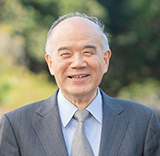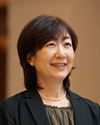
ここからコンテンツです。

Contributing to Society through Continuous Development of R&D
Takashi Onishi

R&D at the university level is crucial in that it allows for continuous, high-quality research, the achievements of which can be applied by companies and other organizations in order to benefit society. What kinds of initiatives should be taken to encourage such research? Toyohashi University of Technology president Takashi Onishi has worked both to ensure the continuous development of the university’s R&D, and to improve the university’s capabilities by promoting collaborative research with top institutions and leading companies in Japan and around the world. We asked President Onishi about the five and a half years of research and development initiatives he has led since taking up his position in 2014.
Interview and report by Madoka Tainaka
About the Research Institute for Technological Science and Innovation (RITI)
In recent times, individuals in the national government and cabinet have been using the media to vigorously attack Japanese universities, particularly national universities. They mention declining university research capabilities and a lack of competitiveness among universities as factors hindering Japan’s competitiveness in the international community. As we can see by the increased numbers of international students in Japan, students today are more likely to think globally. In order to demonstrate the value of universities in society, it is crucial to conduct high-quality R&D and work to ensure its continuous development going forward.
To help address these issues, Toyohashi University of Technology established the Research Institute for Technological Science and Innovation (RITI) in 2016, pushing for reforms in R&D. Leading these reforms is Takashi Onishi, who has served as the university’s president since April 2014.
"RITI serves as a framework for conducting research focused on industry-academic partnerships and social partnerships as well as working to further develop our research activities based in the Electronics-Inspired Interdisciplinary Research Institute (EIIRIS) and four other research centers," explains Onishi.
"RITI has also established a Strategic Research Division and works to promote research across three different categories. Specifically, the three categories consist of the Emergent Systems Research Division, which carries out collaborative research with companies, the Social Systems Research Division, which carries out research on regional communities with local governments, and the Advanced (Interdisciplinary) Research Division, which carries out cutting-edge research with advanced research institutions in Japan and overseas."
The Emergent Systems Research Division carries out jointly-funded collaborative research with companies. The university provides a specific amount of research funds (4 to 10 million yen), and the partnering company provides an amount that is equal or greater. This configuration ensures that highly productive research can be conducted. By offering a greater amount of funding than is typical for joint research, the university can broaden its perspective to include social implementation instead of simply stopping at component technology development.
Similarly, with the Social Systems Research Division, funds are provided jointly by the university and a local municipality. Initiatives address societal issues in regional communities.
Meanwhile, the Advanced (Interdisciplinary) Research Division aims to improve the sophistication and diversity of research at the university by collaborating with researchers from Japanese and overseas institutions that possess advanced research capabilities.
"For Emergent Systems Research (which is joint research conducted with companies), we are presently moving forward with 12 projects focusing on next-generation fuel cells, robotics, and sensing devices," says Onishi. "The Advanced (Interdisciplinary) Research Division has established joint research laboratories with the National Institute of Advanced Industrial Science and Technology, the University of Stuttgart, and others, pursuing research focused on sensors and new device development, all while working closely with a rotation of young researchers."
Strengthening Research Support Systems and Promoting the University's Achievements
Since TUT incorporated as a national university corporation in 2004, management expense grants from the national government have declined, making it difficult for national universities to operate. Under these circumstances, it is not easy to find large budgets for new R&D expenses. In this regard, President Onishi says that initiatives to increase joint research are essential to ensure continuous development of the university.
"Toyohashi University of Technology adopted measures to strengthen its research in 2013," he recalls. "As a part of these measures, the university hired URAs (University Research Administrators) as specialized staff members hired to support research and established the RAC (Research Administration Center), which serves as an organization that widely publicizes the university's research achievements to society. There are presently 13 specialized staff serving as URAs and coordinators.
"This organization serves to coordinate and tailor the university’s research to meet the needs of society. This includes pitching university research to companies, helping to match with companies, and providing a variety of other R&D-related support. Such activities require a wide range of skills, including fluency in other languages, the ability to negotiate with research institutions overseas, management of university data, and occasionally consulting with students. Negotiating with companies is also essential, so naturally, more than half of our staff have abundant experience in the corporate world," says Onishi.
In the past, people with such roles did not work in Japanese universities. However, in order to ensure the continuous development of university R&D, it has become crucial to promote open innovation and showcase the university’s achievements to the outside world. As such, the URA is indispensable.
Meanwhile, associated personnel costs are an overhead expense that must be financed through external funding. The university cannot simply rely on subsidies and management expense grants and must secure external funds. Without the ability to sustain the mechanisms to support research, the university cannot expect to operate stably or maintain its quality.
To address this, the university has made efforts to increase overhead expenses for research support from 10% to 30% in relation to direct expenses (expenses directly related to research). In countries like the United States, it is already normal to have around 50% of overhead expenses secured. In Japan, overhead expenses account for 30% of scientific research grants.
"On an individual level, the significance of overhead expenses has not been fully realized. I believe that securing an environment that supports research both institutionally and financially will contribute to the continuous development of R&D throughout the university. We will need to continue such efforts going forward," says Onishi.
Using Japanese Urban Planning Methods in University Management
The university’s steady investments in R&D are paying off, to the extent that we are now witnessing a variety of achievements by its Advanced Research Division, Electronics-Inspired Interdisciplinary Research Institute (EIIRIS), and four other research centers focused on robotics, agriculture, disaster prevention, and future vehicles.
In particular, EIIRIS has a semiconductor research facility that essentially makes it a factory for LSI chips. In addition to prototyping specialized smart sensors and photonic devices, the institution also has a tenure track system that allows it to serve as a platform for young researches to independently conduct ongoing research. “We have done pretty well in terms of creating an ideal environment for R&D,” Onishi proudly states.
In fact, Onishi says that creating such an environment required looking to his own field of expertise.
"I specialize in urban planning, which consists of creating a master plan for the future and considering a methodology to achieve it. Of course, this requires funding. In addition to relying on external funds, money has to be created and circulated internally. In that sense, urban planning and university management are similar.
"I was inspired by a traditional Japanese approach to urban development known as land readjustment. This system had landowners provide small increments of private land to create public spaces such as parks and roads that were integral to the city. Giving up their land was painful for the landowners, but doing so increased the value of the entire community and led to an increase in the value of their own assets as well. It was a system that required collaboration from everyone. This single revelation in urban planning is now known throughout the world," says Onishi.
The university continues to push forward on joint research activities with RITI and provide money to increase joint research funding. These activities are creating a beneficial cycle that increases overhead expenses and contributes to high-quality research.
"Though we are only halfway there, I believe we have found an approach that will allow for the continuous development of university R&D," concludes President Onishi.
Reporter's Note
President Onishi will conclude his term as university president in March 2020. While his plans from April onwards have yet to be decided, he expresses a desire to use his knowledge to contribute to sustainably developing Japan’s cities.
"Recently, Japan’s declining population is said to be causing difficulties in sustaining local municipalities. In fact, I have continued to sound the alarm about this issue since as early as the 1990s. Awareness of this crisis has now spread. Going forward, I want to focus on examining how to redesign Japan’s cities following the decline in population," says President Onishi. In tackling Japan’s largest societal issue, Onishi has set his sights on another difficult challenge.
研究開発を持続的に発展させ、社会に貢献するために
大学における研究開発の重要な役割とは、質の高い研究開発を継続的に行い、その成果が企業などによって実用化されることで、世の中に役立つことにある。そのためにどのような取り組みをすべきなのか。豊橋技術科学大学の大西隆学長は、国内外のリーディング企業やトップ研究機関との協働研究を進めることにより、研究力の向上を図りながら、持続的発展のためのしくみづくりに注力してきた。2014年の学長就任以来、5年半にわたる研究開発の取り組みについて聞いた。
技術科学イノベーション研究機構(RITI)とは
昨今、日本の大学、とくに国立大学に関して、国内メディアを通じて、国や行政などからの厳しい声が伝えられている。国際社会における日本の競争力の低下の一因に、大学の研究力低下や大学間の競争力不足があるというのだ。留学生の増加に見られるように、グローバルでの学生の流動性が高まるなか、大学が存在価値を示すためには、それぞれの特色を打ち出し、質の高い研究開発を行い、継続・発展させていくほかない。
そうしたなか、豊橋技術科学大学では2016年に「技術科学イノベーション研究機構(RITI)を設置し、研究開発における改革を進めてきた。その改革を牽引してきたのが、2014年4月から5年半にわたり豊橋技術科学大学の学長を努めてきた大西隆である。
「RITIとは、既存のエレクトロニクス先端融合研究所と4つのリサーチセンターをベースに進めてきた研究活動をより発展させるとともに、産学連携、社会連携を重視した研究を行っていくための枠組みです。
この中に戦略研究部門を設置し、研究を3つのタイプに分けて推進してきました。具体的には、企業と協働研究を行う『創発型システム研究部門』、自治体などと地域を対象とした研究を行う『社会システム研究部門』、国内外の先端研究機関と共同で先端研究を行う『先端(融合)研究部門』の3部門です」と大西学長は説明する。
創発型システム研究部門とは、いわゆるマッチング方式ファンドによる企業との協働研究である。すなわち、大学側も一定規模の研究資金(400〜1000万円)を用意しながら、企業からはそれ以上の資金を積み上げてもらうことで、充実した研究開発を行う取り組みだ。従来の共同研究よりも大きな資金を用意することで、要素技術の開発に止まらず、社会実装までを視野に入れる。
社会システム研究部門も同様に、大学と自治体双方が資金を出し合い、地域の社会課題解決に向けた取り組みをしていく。
一方、先端(融合)研究部門は、高度な研究水準を有する国内外の研究機関の研究者と協働することにより、本学の研究の高度化や多様化を図ることを目的としている。「創発型システム研究、すなわち企業との共同研究では、次世代燃料電池やロボット、センシングなどをテーマに、現在12プロジェクトが動いています。先端(融合)研究部門では、産業技術総合研究所やシュトゥットガルト大学と、それぞれ共同研究ラボラトリーを設置して、センサや新デバイスの開発をテーマに、若手研究者の人的循環を密にしながら研究を究めているところです」
研究支援体制を強化して、本学の成果を周知する
2004年の国立大学法人化以降、運営費交付金が減少し、国立大学の運営が厳しくなるなかで、新たに研究開発費として多額の予算を捻出することは容易ではなかった。しかし、共同研究を増やすことは、本学の持続的発展のために欠かせない取り組みだったと、大西学長は振り返る
「豊橋技科大は2013年に研究大学強化促進事業に採択され、その一環として、URA(University Research Administrator)、すなわち研究推進支援を担う専門人材を採用し、大学の研究成果を社会へ広く伝えていくための組織として、RAC(Research Administration Center)を設置しました。現在、URAおよびコーディネーターとして13名の専門職員を採用しています。
この組織は、大学の研究と社会のニーズを結びつけ、研究をコーディネイトする役割を担います。言うなれば、大学の研究を企業に売り込んだり、企業とのマッチングを差配したり、研究開発に関わるさまざまな支援を行ったりするわけですね。そのためには、語学に堪能で海外研究機関との折衝に長けていたり、大学内のデータを管理したり、ときには学生の相談に乗ったりと、さまざまなスキルが求められる。企業との折衝も不可欠ですから、当然、企業のことをよく知る企業経験者が大半を占めています」と大西学長。
かつて、日本の大学にそのような役割の人はいなかったが、大学の研究開発を持続的に発展させていくためには、大学の成果を外部にアピールしてオープンイノベーションを推進していくことは必須であり、URAは必要不可欠な存在と言える。
一方で、その人件費は外部資金が産む間接経費で賄わざるを得ない。補助金や運営費交付金だけに頼ることなく、外部資金を獲得して、研究開発を支えるしくみを維持していかなければ、大学の質の維持と安定的な運営は望めないだろう。
そこで本学が注力してきたのが、研究支援のための間接経費を直接経費(研究に直接関わる費用)に対して1割から3割に引き上げる取り組みだ。すでに米国などでは間接経費を5割程度確保するのが通常で、日本の科研費などでも間接経費は3割となっている。「個々の現場では、間接経費の意義の浸透はまだ十分とは言えません。体制的にも資金的にも、研究支援の環境を整えることが、本学全体の研究開発の持続的発展に寄与することを、今後も周知していく必要があると思っています」(大西学長)
大学経営に生かされた日本の都市計画の方法論
研究開発におけるこのような地道な取り組みが実を結び、いまや先端研究部門はもとより、エレクトロニクス先端融合研究所(EIIRIS)および、「ロボット」「農業」「防災」「未来ビークル」をテーマとする4つのリサーチセンターにおいても、さまざまな成果が生まれつつある。
とくにEIIRSでは、LSI工場と言うべき半導体の研究施設を有し、特色あるスマートセンサやフォトニクス情報デバイスなどを試作するとともに、「テニュアトラック制度」を導入することで、若手研究者が自立して継続的に研究できるプラットフォームとしての機能も果たしてきた。大西学長も、「研究開発の環境づくりという点では、まずまずの成果を残せた」と自負する。
じつはその環境づくりにおいて、自らの専門分野がヒントになったと語る。
「私の専門は都市計画ですが、都市計画というのは、将来あるべきマスタープランを描き、それを実現するための方法論を考えることにあります。当然、そのためには財源が必要であり、外部資金に頼るだけでなく、内部でお金を生み出し、循環させていかなければならない。そういった意味で、都市計画と大学経営は似ているところがあります。
そこで一つのヒントとなったのが、日本特有の都市開発の伝統的手法である『区画整理』です。これは、都市に不可欠な道路や公園などの公共スペースを生み出すために、地主が自分の土地を少しずつ供出する制度です。地主からすれば、自分の土地が減るという痛みは伴いますが、結果として地域全体の価値が高まり、自らの資産価値も上がる。つまり皆が協力する制度です。都市開発の妙案の一つとして世界共通語となっているほどです」
豊橋技術科学大学が進めるRITIの共同研究も、大学側も資金を提供し、共同研究資金を増やすことで、結果として間接経費を増やし、質の高い研究を生み出す好循環へとつながっている。
「まだ道半ばではありますが、大学の研究開発を持続的に発展させていくための一つの方法論を示すことができたのではないかと思っています」と大西学長は締めくくった。
(取材・文=田井中麻都佳)
取材後記
大西学長は、2020年3月で学長としての任を終える。4月以降の身の振り方は未定としつつも、今後は、自身の専門を生かして、日本の都市の持続的発展のために寄与していきたいと語る。
「昨今、日本の人口減少によって、地方都市の自治の維持が困難になると言われていますが、じつは私はこの問題に、1990年代という早い時期から警鐘を鳴らし続けてきました。すでにその危機意識は共有されましたので、今後は、人口が減った後の日本の都市をいかにリデザインしていくのか、そこに注力していきたい」と大西学長。日本最大の社会課題の解決へ。そのまなざしは、さらなる難題に向けられている。
Researcher Profile

Dr. Takashi Onishi
Dr. Takashi Onishi received PhD degree in engineering in 1980 from the University of Tokyo. He was placed in a key position for President of Science Council of Japan from 2011 to 2017 and Vice President of The Japan Association of National Universities from 2015 to 2017. In 2014, he was assigned seventh President of Toyohashi University of Technology and is almost ending his term.
Reporter Profile

Madoka Tainaka is a freelance editor, writer and interpreter. She graduated in Law from Chuo University, Japan. She served as a chief editor of "Nature Interface" magazine, a committee for the promotion of Information and Science Technology at MEXT (Ministry of Education, Culture, Sports, Science and Technology).
ここでコンテンツ終わりです。
